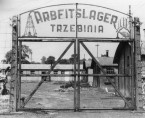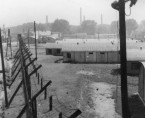Trzebinia
A sub-camp created at the beginning of August 1944 at the Erdöl Rafinerie Trzebinia GmbH. It replaced a camp for about 200 British POWs who had just been sent to Lamsdorf POW camp. 300 prisoners were placed in the barracks they left behind, then another 300 two weeks later, and a further 200 in mid-September.
There were a total of six barracks in the camp, four of which were made of corrugated sheet metal and housed prisoners. They were surrounded by an electrified barbed-wire fence hung on wooden posts. SS-Unterscharführer Wilhelm Kowol was camp director. He had about 60 SS men at his disposal. The prisoners, mostly Jews from Hungary and Poland, worked at expanding the refinery by digging ditches, excavating foundations, laying pipes, installing sewerage, and building railroad tracks and air-raid shelters.
After a raid by American Flying Fortresses in August 1944, the prisoners were also used to repair damage and dig up unexploded ordnance. The work was unusually hard and exhausting, and constant admonitions from refinery management about raising productivity and quickening the tempo of labor only made the situation worse. Tightening supervision and replacing Jewish Kapos with German ones were the specific steps taken. Although management felt that this measure yielded the desired results, it is nevertheless clear from detailed reports on labor effectiveness that in fact it had the opposite effect—prisoners could not work any more efficiently, even when they were beaten.
In the face of the high death rate, the SS authorities decided to install a mazut-fired metal crematorium in the camp. In January 1945, the prisoners were evacuated on foot to Rybnik, and from there by rail to the Sachsenhausen and Bergen-Belsen camps.

